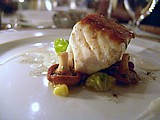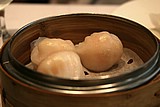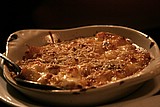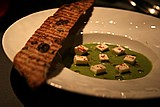Home |
Restaurants by City
|
Food Photography |
Archive | Philosophy |
![]()
Right now we are eating in Seattle, Washington.
|
Wednesday
2005
Permalink
|
Mistral, Seattle, WA, tasted on September 25, 2004 — The other night Debbie and I ate at a local Seattle restaurant and realized that we still hadn't posted our description of our last meal there. Rather than wait any longer, that post is here right now. And to be honest, while it's taken awhile, I think it's worth the wait. Eating at Mistral over the last few years has been somewhat of an evolution. And even though we've only been there a handful of times, the evolution of the restaurant is quite clear. To be honest, things started out rocky way back when we first tried to eat at Mistral. That first visit and our second chance visit much later are documented in detail here. But since then we've eaten at Mistral twice, and it's now become a place we like to eat regularly. Let's get to the details. I hate to characterize restaurants in some broad categorical way, but I do think a high level description of Mistral is not without its usefulness. Mistral is a cozy modern restaurant, tucked away on a downtown Seattle side street. The food is essentially modern French cooking. And strangely enough it reminds me mostly of French meals I had in London, Pied à Terre in particular. Think refined, minimalist French. Definitely not overly sauced like more classical French cooking. Fresh seasonal ingredients. Extensive tasting menus. Mistral offers three different tasting menus - The Market Menu, The Chef's Tasting Menu, and The Mistral Experience. That last one is the most expensive and of course, the most inclusive. So of course, that's what we got. It had been two years since we'd eaten at Mistral. I hadn't quite remembered the inside, a little dark in a romatic way, quiet, and comfy. Clean lines. We started off with a half bottle of Champagne - Billecart Salmon Brute Rose. It had a lemony touch to it. The amuse followed quickly - Japanese Hamachi Tartare with Cucumber, Yogurt, and Dill. It had simple, clean, tart, and fresh flavors. Kind of a Greek touch to it. Soup was next. Specifically the Matsutake Mushroom Soup with Seared Sea Scallop and Rosemary "Cloud" (cloud means foam/emulsion). The soup was thick and rich like a yummy mushroom shake. Believe me this is a good thing. The scallop had little bursts of Indian spice as well as little crystal salt spikes on the tongue. The soup was quite delicious, but what followed was I think the emblematic dish of the evening - Pacific Sablefish, Kohlrabi, Chanterelles and Vanilla. Sablefish is another word for Black Cod. The Vanilla was a nice touch. The grapes were little sweet and sour jewels dotting the landscape. The fish was beautifully cooked with a perfectly crispy top. The brussel sprout cups were also crispy not to mention crunchy and delicious. Yum! I need to give some context for this dish. As I mentioned above, I've almost only tasted fish prepared like this in Europe. And Mistral is definitely the only place that prepares it like this in Seattle. Imagine a cube of perfectly flaky buttery fish bound to a square of crispy skin and dotted with a few select perfectly cooked vegetables. It's just a singular experience and Mistral does it well. The fish that followed, Alaskan Halibut, Lobster and Beansprout "Risotto", was good as well, but as Mary Alice put it, the first was "exciting". Foie gras was next. Artisan Foie Gras, Passionfruit Jelly, and Crispy Apple. The apples were definitely crispy and extra thin. The foie was decently salty. The passionfruit jelly was super delicious. The foie could have been even crispier but the salt spikes and fruit acidity were a good combination. The entrees showed up next. Two of us got the Breast of South Moulard Duck, Berber Spice, and Cauliflower, and the other two got the Rack of Oregon Lamb, Organic Chard, and Fingerling Potato Puree. Both the duck and the lamb were quite yummy each with consistently warm savory tones. The extra smooth wide flavor of the respective meat in each dish expands slowly in your mouth and feels uniform across your palate. We wrapped things up with some good cheese not to mention ice cream and a bit of layered cake. The dessert was refined, deliberate, and good. Two years ago we felt that if Mistral kept working at it, they could really become a destination we'd want to eat at repeatedly. They have. It's not only that the cuisine is unique in this area, it also happens to be quite good. And when we went back this past week, Mistral didn't disappoint. ∞ Surprisingly, Seattle is not the only place where you can eat Mistral's food. There's now a Mistral Bangkok. Neat. |
|||
Our Sponsors
Free Car Listings – Hot Tubs – Stools – Saunas – Bar Stools - Calendar and Event Schedules - Food Events and Calendars - Wine Events and Calendars - Digital Photography Resources - Software for Advertisers - Jewish Gifts and Judaica - Howard Stern Podcast - ponytailed blogger Jonathan Schwartz

Browse tastingmenu
Home |
Restaurants by City X |
Food Photography |
Archive | Philosophy |
![]()
Free eBooks: All About Apples
| Autumn Omakase
More:
Discussion |
Cool Food T-Shirts |
Ingredients
| Markets |
Recipes
Search |
Blog FAQ |
Other
Blogs
Best of tastingmenu
|
City View
Entry: July 6, 2006 |
Blue Plate
Entry: June 19, 2006 |
L'Atelier de Joël Robuchon
Entry: July 18, 2006 |
Browse by City
Boston | Chicago | Houston | Las Vegas | Los Angeles | Maui | New York | Philadelphia | Portland | San Francisco | Seattle | Toronto | Utah | Vancouver | Washington D.C.
Bangkok | Beijing | Hong Kong | Seoul | Tokyo
Amsterdam | Berlin | Italy | London | Madrid | Paris | Vienna
Browse by Month
2006
2005
2004
2003
2002
2001
Comments, questions, or feedback:
info / at / tastingmenu / dot / com
All pages Copyright (c) 2001-2006 tastingmenu.com
Last modified 01/30/07.




